Yaesu FT-897 Operating Manual

HF/VHF/UHF
ALL MODE TRANSCEIVER
FT-897
Operating Manual
VERTEX STANDARD CO., LTD.
4-8-8 Nakameguro, Meguro-Ku, Tokyo 153-8644, Japan
VERTEX STANDARD
US Headquarters
10900 Walker Street, Cypress, CA 90630, U.S.A.
YAESU EUROPE B.V.
P.O. Box 75525, 1118 ZN Schiphol, The Netherlands
YAESU UK LTD.
Unit 12, Sun Valley Business Park, Winnall Close
Winchester, Hampshire, SO23 0LB, U.K.
VERTEX STANDARD HK LTD.
Unit 5, 20/F., Seaview Centre, 139-141 Hoi Bun Road, Kwun Tong, Kowloon, Hong Kong

Contents
Introduction ............................................................................ |
1 |
Specifications........................................................................... |
2 |
Accessories & Options ............................................................ |
3 |
Installation............................................................................... |
4 |
Power connections................................................................. |
4 |
External DC power source operation ............................ |
4 |
AC power source operation ........................................... |
5 |
Internal battery operation .............................................. |
6 |
Grounding ............................................................................. |
7 |
Mobile Station Grounding ............................................. |
7 |
Base Station Earth Grounding ....................................... |
7 |
Antenna Considerations ........................................................ |
8 |
Mobile Antenna Installations......................................... |
8 |
Base Station Antenna Installations ................................ |
8 |
RF Field Exposure................................................................. |
9 |
Electromagnetic Compatibility.............................................. |
9 |
Heat and Ventilation .............................................................. |
9 |
Linear Amplifire Interfacing................................................ |
10 |
CW Key/Keyer Connections ............................................... |
11 |
Receiver Accessories (Tape Recorder etc.) ......................... |
11 |
Adjusting the Front Feet ...................................................... |
11 |
Front Panel Control & Switches ......................................... |
12 |
Rear panel Connectors ......................................................... |
18 |
Top & Bottom Panel Connectors......................................... |
19 |
Operation............................................................................... |
20 |
Turning the Transceiver On and Off.................................... |
20 |
Operating Band Selection ................................................... |
20 |
Mode Selection ................................................................... |
21 |
Adjusting the Audio Volume Level ..................................... |
21 |
Adjusting the RF Gain and Squelch .................................... |
21 |
Setting the Operating Frequency ......................................... |
22 |
Stacked VFO System ........................................................... |
22 |
Changing the Dial Speed ..................................................... |
22 |
Receiver Accessories ............................................................. |
23 |
Locking Front Panel Controls ............................................. |
23 |
Clarifier ............................................................................... |
23 |
IF Shift ................................................................................ |
24 |
AGC .................................................................................... |
24 |
Noise Blanker ...................................................................... |
25 |
IPO ...................................................................................... |
25 |
ATT ..................................................................................... |
25 |
DSP Bandpass Filter............................................................ |
25 |
DSP CW Peaking Filter ....................................................... |
26 |
DSP Noise Reduction .......................................................... |
26 |
DSP Notch Filter ................................................................. |
26 |
AM/FM Tuning Dial Operation .......................................... |
27 |
Automatic Power-Off Feature ............................................. |
27 |
Transmitter Operation ......................................................... |
28 |
SSB/AM Transmission ........................................................ |
28 |
Basic Setup/Operation ................................................. |
28 |
VOX Operation ........................................................... |
28 |
AF Speech Processor Operation.................................. |
29 |
DSP Microphone Equalizer ......................................... |
29 |
CW Transmission ................................................................ |
30 |
Operation using Straight Key/External Keying Device..... |
30 |
Using the Built-in Electronic Keyer ............................ |
31 |
FM Transmission ................................................................. |
32 |
Basic Setup/Operation ................................................. |
32 |
Repeater Operation...................................................... |
32 |
Tone Search Scanning ................................................. |
33 |
DCS Operation ............................................................ |
34 |
DCS Search Scanning ................................................. |
34 |
Split Tone Operation ................................................... |
34 |
ARTSTM Operation ...................................................... |
35 |
CW Identifier Setup..................................................... |
35 |
Digital Mode Operation ...................................................... |
36 |
RTTY (Radio Tele Type) Operation ............................ |
36 |
PSK31 Operation ........................................................ |
37 |
Packet (1200/9600 bps FM) Operation ....................... |
37 |
WeatherFax Monitoring ...................................................... |
38 |
Time-Out Timer ................................................................... |
38 |
Split Frequency Operation .................................................. |
38 |
Active-Tuning Antenna System (ATAS-100/-120) Operation..... |
39 |
Automatic Tuning ........................................................ |
39 |
Manual Tuning ............................................................ |
39 |
ATAS-100/-120 Operating Tips .................................. |
40 |
Grounding.................................................................... |
40 |
Tuning Procedure ........................................................ |
40 |
External Wattmeters .................................................... |
40 |
Operation on 30/17/12 Meters .................................... |
40 |
FC-30 Automatic Antenna Tuner Operation........................ |
41 |
Antenna Tuner Memory System .................................. |
41 |
Memory Operation ............................................................... |
42 |
QMB (Quick Memory Bank) Channels .............................. |
42 |
QMB Channel Storage ................................................ |
42 |
QMB Channel Recall .................................................. |
42 |
Memory Operation on “Regular” Memory Channel ........... |
42 |
Normal Memory Storage ............................................. |
42 |
Split-Frequency Memory Storage ............................... |
42 |
Memory Channel Recall .............................................. |
43 |
Masking (“Hiding”) a Memory ................................... |
43 |
Memory Operation on “HOME” Channel Memories.......... |
44 |
HOME Channel Storage .............................................. |
44 |
HOME Channel Recall................................................ |
44 |
Labeling Memories ............................................................. |
44 |
Spectrum Scope Monitor ..................................................... |
45 |
Smart SearchTM ..................................................................... |
45 |
Scanning Operation .............................................................. |
46 |
Scanning Features................................................................ |
46 |
Scanning Operation ..................................................... |
46 |
Scan-Resume Choices ................................................. |
46 |
Scan Skip Programming (Memory Mode only) .......... |
47 |
“Priority Channel” Scanning ............................................... |
47 |
Programmable Memory Scan (PMS) Operation ................. |
48 |
Dual Watch Operation ......................................................... |
48 |
Miscellaneous Settings.......................................................... |
49 |
Operation on Alaska Emergency Frequency:5167.5 kHz ... |
49 |
CW Training Feature ........................................................... |
49 |
Programming the Panel Key Functions ............................... |
49 |
Beacon Feature .................................................................... |
50 |
Beacon Text Storage .................................................... |
50 |
Beacon Text Sending (On the Air) .............................. |
50 |
Display Customization ........................................................ |
51 |
Display Lamp Mode .................................................... |
51 |
Display Contrast .......................................................... |
51 |
Display Dimmer .......................................................... |
51 |
Display Color .............................................................. |
51 |
Menu Operation.................................................................... |
52 |
CAT (Computer Aided Transceiver) Operation .............. |
61 |
Power-On Microprocessor Reset Procedures .................... |
63 |
Cloning................................................................................... |
63 |
Installation Optional Accessories ........................................ |
64 |
Optional Filters:YF-122S and YF-122C ............................. |
64 |
Optional High Stability Reference Oscillator TCXO-9 ...... |
65 |
External Automatic Antenna Tuner “FC-30”....................... |
66 |
Appendix................................................................................ |
67 |
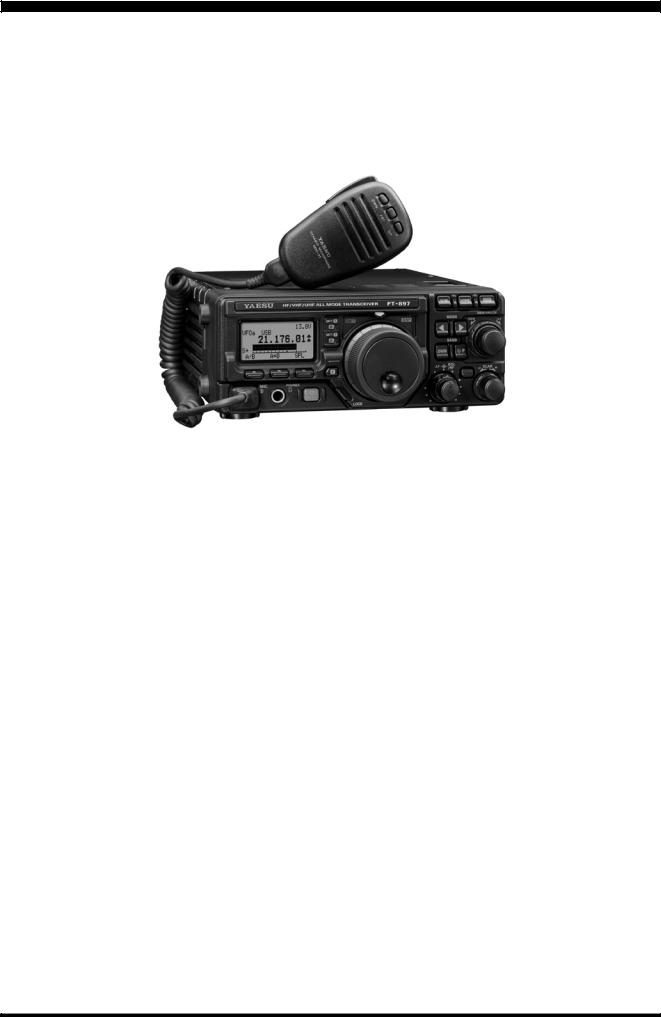
INTRODUCTION
The FT-897 is a rugged, innovative multiband, multimode portable transceiver for the amateur radio MF/HF/ VHF/UHF bands. Providing coverage of the 160-10 meter bands plus the 6 m, 2 m, and 70 cm bands, the FT-897 includes operation on the SSB, CW, AM, FM, and Digital modes, yielding the most comprehensive performance package available for field operation.
Designed for use from (1) an external DC power source,
(2) internal battery (requires optional FNB-78 Ni-MH battery pack), or (3) AC power source (requires optional FP30 External AC Power Supply), the FT-897 provides 100 watts of power output from a 13.8-Volt external power supply or AC operation. When using the optional FNB-78 NiMH Battery Pack, the FT-897 automatically switches to 20 Watts (430 MHz:10W) of output power.
The multi-function Liquid-Crystal Display includes attractive backlighting, which may be disabled for battery conservation. The display includes bar-graph indication of power output, ALC voltage, SWR, and modulation level. Also include are a number of operating status icons, as well as the function displays for the three operating function keys (A, B, and C).
Among the advanced features of the FT-897 are many incorporated only in large base-station transceivers. These include Dual VFOs; Split-Frequency operation; Digital Signal Processing (Bandpass Filtering, Noise Reduction, Notch, and Microphone Equalizer); IF Shift; Clarifier (“R.I.T.”); IF Noise Blanker; AGC Fast/Slow/Auto/Off selection; RF Gain and Squelch control; IPO (Intercept Point Optimization) and a receiver front-end Attenuator; AM Aircraft reception; AM and FM Broadcast reception; U.S. Weather Band reception; VOX; Built-in Electronic Keyer; Adjustable CW Pitch; Automatic FM Repeater Shift (ARS); Builtin CTCSS Encoder/Decoders; ARTS™ (Auto-Range Transponder System); Smart Search™Automatic Memory Loading System; Spectrum Scope; 200 Memories plus Home Channels and Band-limiting Memories; Alpha-Numeric Labeling of Memories; Automatic Power-Off (APO) and Time-Out Timer (TOT) functions; Computer Interface capability; and Cloning capability.
We urge you to read this manual in its entirety, so as to gain a full understanding of the amazing capability of the exciting new FT-897 Transceiver.
FT-897 OPERATING MANUAL |
Page 1 |

SPECIFICATIONS
General
Frequency Range: |
Receive: 0.1-56 MHz, 76-108 MHz, 118-164 MHz, 420-470 MHz |
|
Transmit: 160 - 6 Meters, 2 Meters, 70 Centimeters (Amateur bands only) |
|
5.1675 MHz (Alaska Emergency Frequency: USA only) |
Emission Modes: |
A1 (CW), A3 (AM), A3J (LSB/USB), F3 (FM), |
|
F1 (9600 bps packet), F2 (1200 bps packet) |
Synthesizer Steps (Min.): |
10 Hz (CW/SSB), 100 Hz (AM/FM/WFM) |
Antenna Impedance: |
50 Ohms, Unbalanced (M) |
Operating Temp. Range: |
+14 °F to +140 °F (–10 °C to +60 °C) |
Frequency Stability: |
±4 ppm from 1 min. to 60 min after power on. @25 °C: 1 ppm/hour |
|
±0.5 ppm/1 hour @25 °C, after warmup (with optional TCXO-9) |
Supply Voltage: |
Normal: 13.8 VDC ±15 %, Negative Ground |
|
FNB-78 (Ni-MH Battery Pack): 13.2 V (Option) |
Current Consumption: |
Squelched: 600 mA (Approx.) |
|
Receive: 1 A |
|
Transmit: 22 A |
Case Size (W x H x D): |
7.87” x 3.15” x 10.3” (200 x 80 x 262 mm) |
Weight (Approx.): |
8.6 lb (3.9 kg) (w/o Ni-MH battery, antenna, Microphone) |
Transmitter
RF Power Output (@13.8 V DC): |
|
SSB/CW/FM |
AM Carrier |
|
160- 6 Meter: |
100 W |
25 W |
|
2 Meter: |
50 W |
12.5 W |
|
70 Centimeter: |
20 W |
5 W |
Modulation Types: |
SSB: Balanced Modulator, AM: Early Stage (Low Level), FM: Variable Reactance |
||
FM Maximum Deviation: |
±5 kHz (FM-N: ±2.5 kHz) |
|
|
Spurious Radiation: |
–50 dB (1.8-29.7 MHz) |
|
|
|
–60 dB (50/144/430 MHz) |
|
|
Carrier Suppression: |
>40 dB |
|
|
Opp. Sideband Suppression: |
>50 dB |
|
|
SSB Frequency Response: |
400 Hz-2600 Hz (–6 dB) |
|
|
Microphone Impedance: |
200-10k Ohms (Nominal: 600 Ohms) |
|
|
Receiver
Circuit Type: |
Double-Conversion Superheterodyne (SSB/CW/AM/FM) |
|||
|
Superheterodyne (WFM) |
|
|
|
Intermediate Frequencies: |
1st: 68.33 MHz (SSB/CW/AM/FM); 10.7 MHz (WFM) |
|||
|
2nd: 455 kHz |
|
|
|
Sensitivity: |
|
SSB/CW |
AM |
FM |
|
100 kHz-1.8 MHz |
– |
32 µV |
– |
|
1.8 MHz-28 MHz |
0.2 µV |
2 µV |
– |
|
28 MHz-30 MHz |
0.2 µV |
2 µV |
0.5 µV |
|
50 MHz-54 MHz |
0.125 µV |
1 µV |
0.2 µV |
|
144/430 MHz |
0.125 µV |
– |
0.2 µV |
|
(SSB/CW/AM = 10 dB S/N, FM = 12 dB SINAD) |
|||
Squelch Sensitivity: |
|
SSB/CW/AM |
FM |
|
|
100 kHz-1.8 MHz |
– |
– |
|
|
1.8 MHz-28 MHz |
2.5 µV |
– |
|
|
28 MHz-30 MHz |
2.5 µV |
0.32 µV |
|
|
50 MHz-54 MHz |
1 µV |
0.16 µV |
|
|
144/430 MHz |
0.5 µV |
0.16 µV |
|
Image Rejection: |
HF/50 MHz: 70 dB, 144/430 MHz: 60 dB |
|
||
IF Rejection: |
60 dB |
|
|
|
Selectivity (–6/–60 dB): |
SSB/CW: 2.2 kHz/4.5 kHz |
|
|
|
|
AM: 6 kHz/20 kHz |
|
|
|
|
FM: 15 kHz/30 kHz |
|
|
|
|
FM-N: 9 kHz/25 kHz |
|
|
|
|
S |
|
|
|
|
|
|
z/2.0 kHz |
|
AF Output: |
2.5 W (@4 Ohms, 10% THD or less) |
|
||
AF Output Impedance: |
4-16 Ohms |
|
|
|
Specifications are subject to change without notice, and are guaranteed within the amateur bands only.
Page 2 |
FT-897 OPERATING MANUAL |

ACCESSORIES & OPTIONS
SUPPLIED ACCESSORIES
Hand Microphone MH-31A8J
DC Power Cord
Operating Manual
Warranty Card
|
AVAILABLE OPTIONS |
|
|
FP-30 |
External AC Power Supply |
FP-1030A |
External AC Power Supply (25A) |
FP-1023A |
Compact Power Supply (23A; U.S.A. only) |
FNB-78 |
Ni-MH Battery Pack (13.2 V, 4500 mAh) |
PA-26B/C/U Ni-MH Battery Charger |
|
CD-24 |
Ni-MH Battery Charger Adapter |
YF-122S |
Collins SSB Filter (2.3 kHz/4.7 kHz: -6 dB/-66 dB) |
YF-122C |
Collins CW Filter (500 Hz/2 kHz: -6 dB/-60 dB) |
TCXO-9 |
TCXO Unit (±0.5 ppm) |
FC-30 |
External Automatic Antenna Tuner |
ATAS-120 |
Active-Tuning Antenna System |
ATBK-100 |
VHF/UHF Antenna Base/Counterpoise Kit |
MMB-80 |
Mounting Braket |
VL-1000 |
Solid-State Linear Amplifier |
MD-200A8X |
Desktop Microphone |
MH-36E8J |
DTMF Microphone |
CT-62 |
CAT Interface Cable |
CT-39A |
Packet Cable |
CT-58 |
BAND DATA Cable |
FT-897 OPERATING MANUAL |
Page 3 |

INSTALLATION
POWER CONNECTIONS
The FT-897 is designed use from (1) an external DC power source, (2) internal battery (requires optional FNB-78 Ni-MH battery pack), or (3) AC power source (requires optional FP-30 Internal AC Power Supply).
External DC power source operation
The DC power connector for the FT-897 must only be connected to a DC source providing 13.8 Volts DC (±15%), and capable of at least 22 Amperes of current. Always observe proper polarity when making DC connections:
The Red DC power lead connects to the Positive (+) DC terminal; and the Black DC power lead connects to the Negative (–) DC terminal.
In mobile installations, noise pickup may be minimized by connecting the DC cable directly to your vehicle’s battery, rather than to the ignition switch or “accessory” circuitry. Direct connection to the battery also provides the best voltage stability.
Tips for Successful Mobile Installations:
Before connecting the DC cable to the battery, measure the voltage across the battery terminals with the engine running fast enough to show a charge. If the voltage is above 15 Volts, the vehicle’s voltage regulator should be adjusted to reduce the charging voltage to 14 Volts or lower.
Route the DC cable as far away from the ignition cables as possible.
If the DC cable is not long enough, use #12 AWG (minimum) stranded, insulated wire to extend it. Be certain to solder the connections at the splice securely, and provide ample insulation for the soldered splice (heat shrink tubing plus black electrical tape work well).
Check the battery terminal connections frequently to be sure they are tight and not corroded.
When operating with the vehicle turned off, or operating from a stand-alone car battery (in a camp site, etc.), be mindful of the minimum operating voltage (11.73 Volts) for the FT-897. If the battery is not charged sufficiently to maintain at least 11¾ Volts at the radio, erratic operation or shut-down may occur.
Caution
Permanent damage can result if improper supply voltage, or reverse-polarity voltage, is applied to the FT897. The Limited Warranty on this transceiver does not cover damage caused by application of AC voltage, reversed polarity DC, or DC voltage outside the specified range of 13.8V ±15%. Never attempt to connect the FT897 to a 24 Volt battery system.
When replacing fuses, be certain to use a fuse of the proper rating. The FT-897 requires a 25Afast-blow fuse.
Page 4 |
FT-897 OPERATING MANUAL |
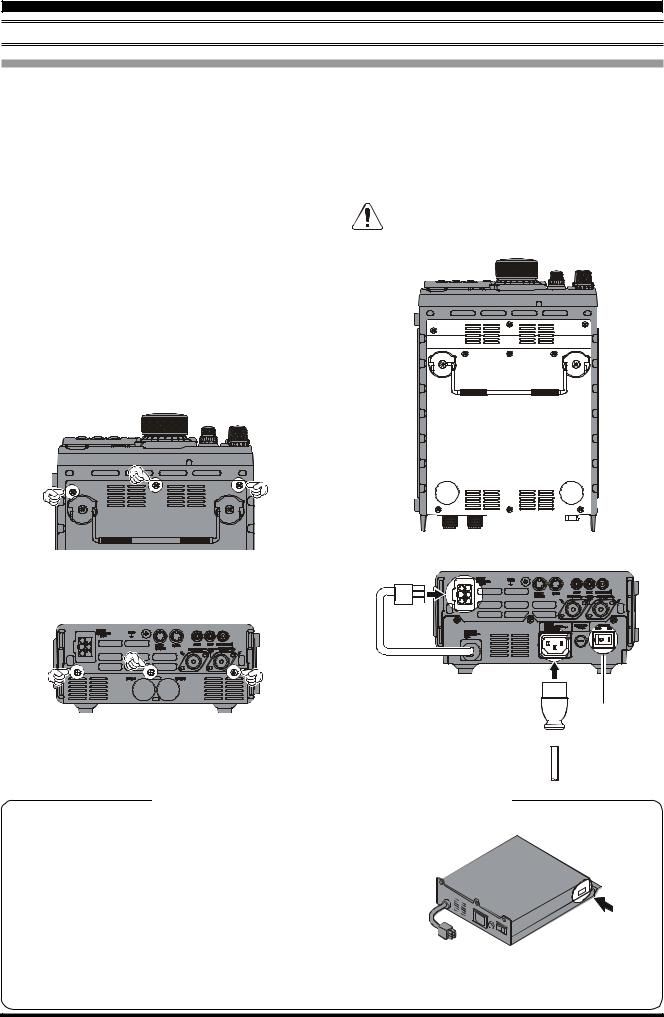
INSTALLATION
POWER CONNECTIONS
AC power source operation (requires optional FP-30 AC power supply)
For base station installations, Yaesu recommends the use of the FP-30 AC power supply, which is designed to clamp onto the FT-897.
Installation
1.Turn the transceiver’s power off, and disconnect all cables from the transceiver.
2.Remove the six screws (three screws on bottom side and rear side), then lift off the bottom cover (Figure 1 and 2).
3.Attach the FP-30 to the bottom of the FT-897, then affix it in place with the six screws removed in the above steps (Figure 3).
4.Connect the 6-pin Molex plug from the FP-30 to the INPUT jack on the rear panel of the FT-897 (Figure 4).
5.Make sure that your AC voltage is correct and that the FP-30 POWER switch is set to Off; connect the AC power cable between the INPUT jack on the rear panel of the FP-30 and a nearby AC wall outlet.
Operation
1.To turn the transceiver on, turn on the POWER switch on the FP-30 before turning on the POWER switch on the FT-897.
2.To turn the transceiver off, turn off the POWER switch on the FT-897 before turning off the POWER switch on the FP-30.
When you do not use the FP-30 with the FT-897 for a long time, disconnect the AC plug from the AC
wall outlet.
Figure 3
Figure 1
Figure 4
POWER Switch
Figure 2
AC Input Voltage Selection (U.S.A. Users only)
Before moving the AC range switch, disconnect the FP-30’s AC Power Cable from the AC line outlet, then wait 10 minutes to allow the power supply’s electrolytic capacitors to discharge (electrical shock hazard!).
Peel off the label on the side of the FP-30.
Move the AC range switch to the “115” position for operation from 100-120 VAC, or to the “230” position for operation from 200-240 VAC.
Always uses the 10 A Fuse in the fuse holder on the rear panel whether operate on 100-120 VAC or 200-240 VAC. Do not use the improper fuse.
Peel off the label
 Warning: Our Warranty does not cover damage caused by improper supply voltage nor use of an improper fuse.
Warning: Our Warranty does not cover damage caused by improper supply voltage nor use of an improper fuse.
FT-897 OPERATING MANUAL |
Page 5 |
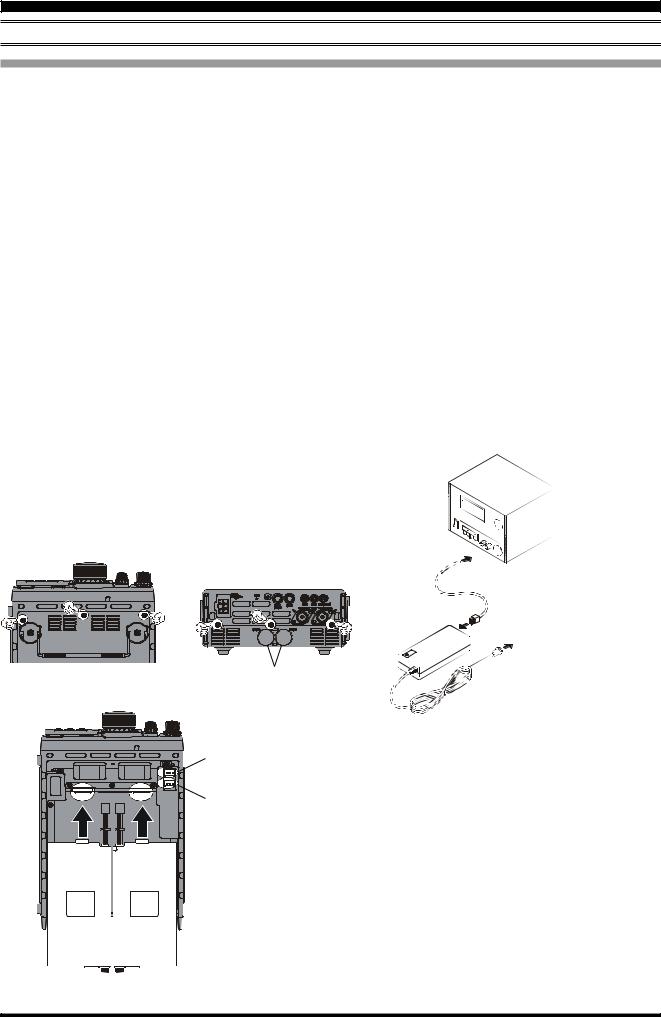
INSTALLATION
POWER CONNECTIONS
Internal battery operation (requires optional FNB-78 Ni-MH battery pack)
The optional FNB-78 Ni-MH Battery Pack provides 13.2 Volts of DC power for your FT-897, with a maximum capacity of 4500 mAh (you may install the two FNB-78 into the FT-897, in this time, maximum capacity is 9 Ah!).
A fully charged set of FNB-78 Ni-MH Battery Pack should provide approximately 4 hours of reception under typical conditions.
Installation
1.Turn the transceiver’s power off, and disconnect all cables from the transceiver.
2.Remove the six screws (three screws on bottom side and rear side), then lift off the bottom cover (Figure 1 and 2).
3.Insert the FNB-78 into the battery compartment “A” or “B”on the bottom of the radio so that the battery’s mounting tab is aligned with the mounting hole on the radio’s chassis (Figure 3).
4.Connect the 3-pin connector from the FNB-78 to the battery jack on the radio’s chassis, corresponding to the label (“A” or “B”) of the battery compartment to which the FNB-78 is installed (Figure 3).
5.Remove the plastic cap, which is same label (“A” or “B”) of the battery compartment witch is the FNB-78 installed, from the to bottom cover, before turning the plastic cap so that the small project of the cap is aligned with the slot of the bottom cover (Figure 2).
6.Replace the bottom cover and its six screws.
Figure 1 |
Figure 2 |
Plastic Cap |
Connector “A”
|
|
A |
|
|
B |
B |
A |
Connector “B” |
|
|
Charging
Charging of the FNB-78 requires the use of the optional CD-24 Charge Adapter.
1.Turn the radio off.
2.Connect the cable plug from the DC Power supply into the INPUT jack on the CD-24 Charge Adapter, then insert the cable plug from the CD-24 into the “CHG-A” or “CHG-B” jack on the rear of the radio.
3.The “BATT-A” or “BATT-B” indicator on the front panel of the FT-897 will glow red (Charging) while the battery is being charged. When charging is completed, the red LED indicator will turn to off (Fully Charged).
A fully-discharged pack will be charged completely in about four hours.
4.Unplug the cable from the CHG terminal, then disconnect the CD-24 from the DC Power supply.
Operation
Before turning the radio on, select the battery (“A” or “B”) to be used by setting the top panel’s A-B switch as appropriate.
AC Power Supply
DC Power Cord
CD-24
CHG jack on the rear of the radio
Figure 3
Page 6 |
FT-897 OPERATING MANUAL |
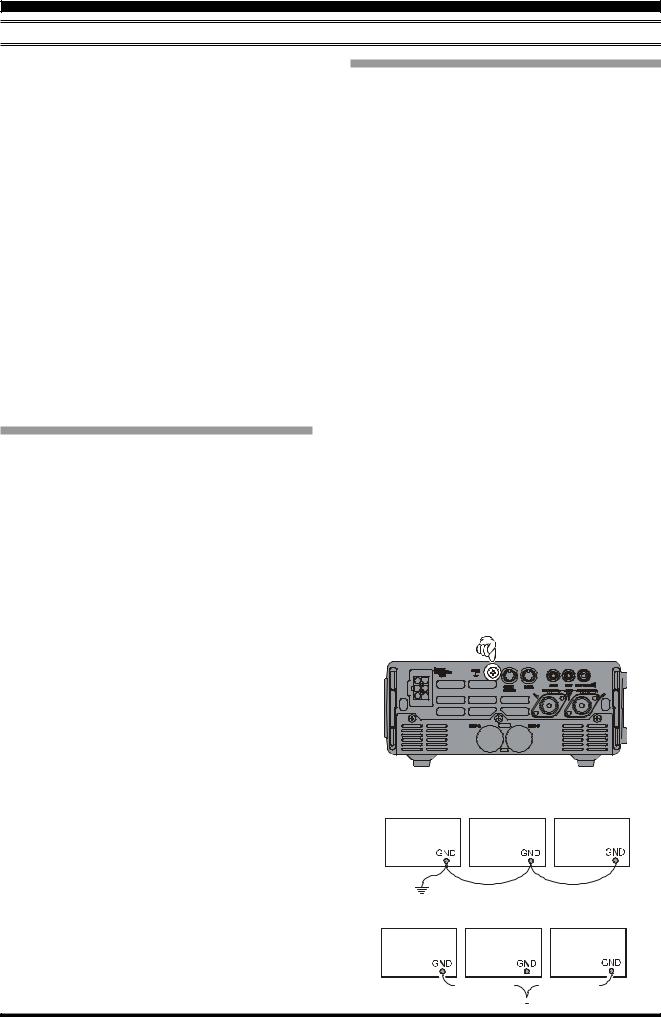
INSTALLATION
GROUNDING
The provision of an effective ground system is important in any successful communications station. A good ground system can contribute to station efficiency in a number of ways:
It can minimize the possibility of electrical shock to the operator.
It can minimize RF currents flowing on the shield of the coaxial cable and the chassis of the transceiver which may cause interference to nearby home entertainment devices or laboratory test equipment.
It can minimize the possibility of erratic transceiver operation caused by RF feedback or improper current flow through logic devices.
An effective earth ground system may take several forms; for a more complete discussion, see an appropriate RF engineering text. The information presented below is intended only as a guideline.
Inspect the ground system – inside the station as well as outside – on a regular basis so as to ensure maximum performance and safety.
Mobile Station Grounding
Although satisfactory grounding in most installations will be achieved via the DC cable’s negative lead and the antenna system’s coaxial cable shield, it is often recommended that you provide a direct ground connection to the vehicle chassis at the mounting location of the transceiver (installation using the optional MMB-80 Mounting Bracket will accomplish this, if the MMB-80 itself is mounted to the vehicle’s chassis). Due to unexpected resonance which may naturally occur in any location, improper communication system performance may result from insufficient grounding. These symptoms may include:
RF feedback (resulting in distortion on your transmitted signal);
Unintended frequency change;
Blinking or blanking of the frequency display;
Noise pickup; and/or



























 ons may occur in any communications installation. The FT-897 includes extensive filtering designed to minimize the chance of such problems; however, random currents set up by insufficient RF grounding can nullify such filtering. Bonding the rear panel Ground lug of the FT-897 transceiver to the vehicle or vessel’s ground system should clear up any such difficulties.
ons may occur in any communications installation. The FT-897 includes extensive filtering designed to minimize the chance of such problems; however, random currents set up by insufficient RF grounding can nullify such filtering. Bonding the rear panel Ground lug of the FT-897 transceiver to the vehicle or vessel’s ground system should clear up any such difficulties.
Vertex Standard does not recommend the use of “on glass” mobile antennas unless the shield of the coaxial cable is securely grounded near the feedpoint of the antenna. Such antennas frequently are responsible for the ground-related difficulties described above.
Base Station Earth Grounding
Typically, the ground connection consists of one or more copper-clad steel rods, driven into the ground. If multiple ground rods are used, they should be configured in a “V” configuration, and bonded together at the apex of the “V” which is nearest the station location. Use a heavy, braided cable (such as the discarded shield from type RG-213 coaxial cable) and strong cable clamps to secure the braided cables to the ground rods. Be sure to weatherproof the connections to ensure many years of reliable service. Use the same type of heavy, braided cable for the connections to the station ground bus (described below).
Do not use gas line pipes in an attempt to provide a ground connection! To do so creates a serious risk of explosion!!
Inside the station, a common ground bus consisting of a copper pipe of at least 25 mm (1”) diameter should be used. An alternative station ground bus may consist of a wide copper plate (single-sided circuit board material is ideal) secured to the bottom of the operating desk. Grounding connections from individual devices such as transceivers, power supplies, and data communications devices should be made directly to the ground bus using a heavy, braided cable.
Do not make ground connections from one electrical device to another, and thence to the ground bus. This so-called “Daisy Chain” grounding technique may nullify any attempt at effective radio frequency grounding. See the drawings below for examples of proper and improper ground connections. If your coaxial cable does not connect directly to the station ground bus, you may connect a ground cable to the Ground lug on the FT-897 rear panel.
GND Terminal
Improper Ground Connection
Transceiver |
Linear |
Power |
|
Amplifier |
Supply |
"Daisy Chain"
Proper Ground Connection
Transceiver |
Linear |
Power |
|||||||
|
Amplifier |
Supply |
|||||||
|
|
|
|
|
|
|
|
|
|
|
|
|
|
|
|
|
|
|
|
|
|
|
|
|
|
|
|
|
|
|
|
|
|
|
|
|
|
|
|
|
|
|
|
|
|
|
|
|
|
FT-897 OPERATING MANUAL |
Page 7 |

INSTALLATION
ANTENNA CONSIDERATIONS
The antenna systems connected to your FT-897 transceiver are, of course, critically important in ensuring successful communications. The FT-897 is designed for use with any antenna system providing a 50 Ω resistive impedance at the desired operating frequency. While minor excursions from the 50 Ω specification are of no consequence, the power amplifier’s protection circuitry will begin to reduce the power output of there is more than a 50% divergence from the specified impedance (less than 33 Ω or greater than 75 Ω, corresponding to a Standing Wave Ratio (SWR) of 1.5:1).
Two antenna jacks are provided on the rear panel of the FT897. The “HF/50 MHz ANT” jack is used for HF and 50 MHz, while the “144/430 MHz ANT” jack is used for 144 MHz and 430 MHz.
Guidelines for successful base and mobile station installations are shown below.
Base Station Antenna Installations
When installing a “balanced” antenna such as a Yagi or dipole, remember that the FT-897 is designed for use with an (unbalanced) coaxial feedline. Always use a balun or other balancing device so as to ensure proper antenna system performance.
Use high-quality 50 Ω coaxial cable for the lead-in to your FT-897 transceiver. All efforts at providing an efficient antenna system will be wasted if poor quality, lossy coaxial cable is used. Losses in coaxial lines increase as the frequency increases, so a coaxial line with 0.5 dB of loss at 7 MHz may have 6 dB of loss at 432 MHz (thereby consuming 75% of your transceiver’s power output!). As a general rule, smaller-diameter coaxial cables tend to have higher losses than larger-diameter cables, although the precise differences depend on the cable construction, materials, and the quality of the connectors used with the cable. See the cable manufacturers’ specifications for details.
Mobile Antenna Installations
Mobile antennas for the HF bands, with the possible exception of those designed for 28 MHz, display very high “Q” due to the fact that they must be physically shortened, then resonated using a loading coil. Additional system bandwidth may be realized using the Yaesu FC-30 Automatic Antenna Tuner, which will present a 50 Ω impedance to your transceiver on the 1.8 ~ 50 MHz bands so long as the SWR on the coaxial line connected to the FC-30 is below 3:1.
On the VHF and UHF bands, coaxial line losses increase so rapidly in the presence of SWR that we recommend that all impedance matching to 50 Ω be performed at the antenna feedpoint.
Yaesu’s Active-Tuned Antenna System (ATAS-100/-120) is a unique HF/VHF/UHF mobile antenna system, which provides automatic tuning when used with the FT-897. See page 39 for full details on the ATAS-100/-120.
For VHF/UHF weak-signal (CW/SSB) operation, remember that the antenna polarization standard for these modes is horizontal, not vertical, so you must use a loop or otherwise horizontally-polarized antenna so as to avoid cross-polar- ization loss of signal strength (which can be 20 dB or more!). On HF, signals propagated via the ionosphere develop mixed polarizations, so antenna selection may be made strictly on mechanical considerations; vertical antennas are almost always utilized on HF for this reason.
For reference, the chart below shows approximate loss figures for typicallyavailable coaxial cables frequently used in HF installations.
Loss in dB per 30 m (100 feet) for Selected 50-ohm Coaxial Cables
|
|
Loss |
|
Cable Type |
1.8 MHz |
28 MHz |
432 MHz |
RG-58A |
0.55 |
2.60 |
>10 |
RG-58 Form |
0.54 |
2.00 |
8.0 |
RG-8X |
0.39 |
1.85 |
7.0 |
RG-8A, RG-213 |
0.27 |
1.25 |
5.9 |
RG-8 Form |
0.22 |
0.88 |
3.7 |
Belden 9913 |
0.18 |
0.69 |
2.9 |
7/8” “Hardline” |
<0.1 |
0.25 |
1.3 |
Loss figures are approximate; consult cable manufacturer’s catalogs for complete specifications.
Always locate antennas such that they can never come in contact with outdoor power lines in the event of a catastrophic support or power-pole structural failure. Ground your antennas’ support structure(s) adequately, so as to dissipate energy absorbed during a lightning strike. Install appropriate lightning arrestors in the antenna coaxial cables (and rotator cables, if rotary antennas are used).
In the event of an approaching electrical storm, disconnect all antenna lead-in, rotator cables, and power cables completely from your station if the storm is not immediately in your area. Do not allow disconnected cables to touch the case of your FT-897 transceiver or accessories, as lightning can easily jump from the cable to the circuitry of your transceiver via the case, causing irreparable damage. If a lightning storm is in progress in your immediate area, do not attempt to disconnect the cables, as you could be killed instantly if lightning should strike your antenna structure or a nearby power line.
If a vertical antenna is utilized, be certain that humans and/ or pets and farm animals are kept away both from the radiating element (to prevent electrical shock and RF exposure danger) and the ground system (in the event of an electrical storm). The buried radials of a ground-mounted vertical antenna can carry lethal voltages outward from the center of the antenna in the event of a direct lightning strike.
Page 8 |
FT-897 OPERATING MANUAL |
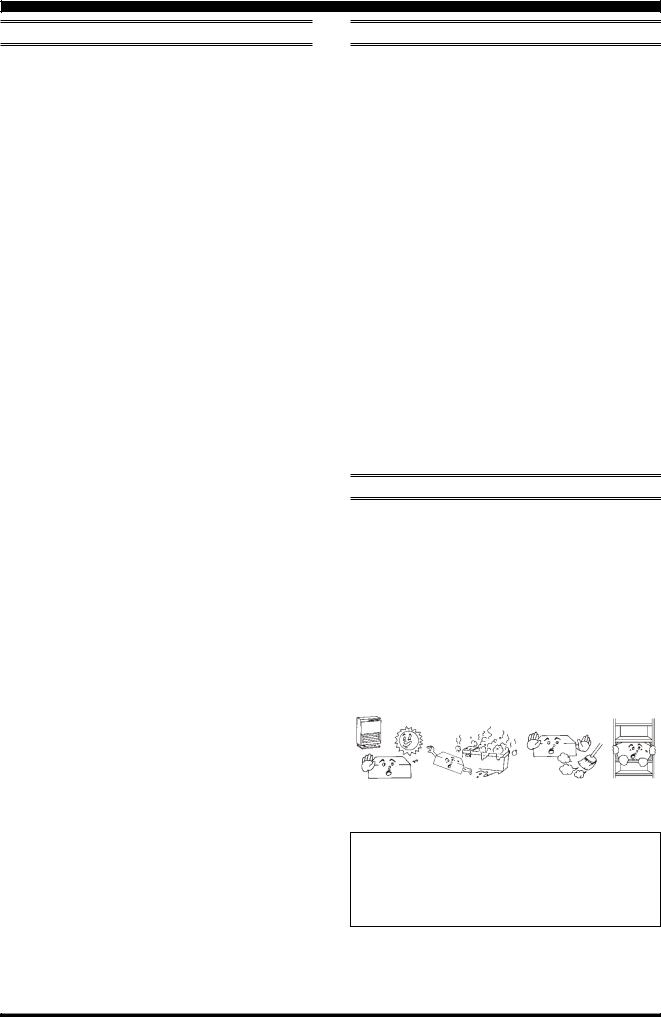
INSTALLATION
RF FIELD EXPOSURE
This transceiver is capable of power output in excess of 50 Watts, so customers in the United States may be required to demonstrate compliance with Federal Communications Commission (FCC) regulations concerning maximum permissible exposure to radio frequency energy. Compliance is based on the actual power output used, feedline loss, antenna type and height, and other factors which can only be evaluated as a system.
Information regarding these regulations may be available from your Dealer, your local radio club, from the FCC directly (press releases and other information can be found on the FCC’s site on the World Wide Web at <http:// www.fcc.gov>), or from the American Radio Relay League, Inc. (225 Main St., Newington CT 06111 or <http:// www.arrl.org>).
Although there is negligible radio frequency (RF) leakage from the FT-897 transceiver itself, its antenna system should be located as far away from humans and animals as practicable, so as to avoid the possibility of shock due to accidental contact with the antenna or excessive long-term exposure to RF energy. During mobile operation, do not transmit if someone is standing adjacent to your antenna, and use the lowest power possible.
Never stand in front of an antenna (during testing or operation) when RF power is applied, especially in the case of 430 MHz directional arrays. The 20 Watt power output supplied by the FT-897, combined with the directivity of a beam antenna, can cause immediate heating of human or animal tissues, and may cause other undesirable medical effects.
ELECTROMAGNETIC COMPATIBILITY
If this transceiver is used with, or in the vicinity of, a computer or computer-driven accessories, you may need to experiment with grounding and/or Radio Frequency Interference (RFI) suppression devices (such as ferrite cores) to minimize interference to your communications caused by energy from the computer. Computer-generated RFI is usually a result of inadequate shielding of the computer’s cabinet or I/O and peripheral connections. While computer equipment may “comply” with RF emission standards, this does not ensure that sensitive Amateur Radio receivers like the FT-897 will not experience interference from the device!
Be certain to use only shielded cables for TNC-to-Trans- ceiver connections. You may need to install AC line filters on the power cord(s) of the suspected equipment, and decoupling ferrite toroidal chokes may be required on interconnecting patch/data cables. As a last resort, you can try installing additional shielding within the computer’s case, using appropriate conductive mesh or conductive shielding tape. Especially check “RF holes” where plastic is used for cabinet front panels.
For further information, consult amateur radio reference guides and publications relating to RFI suppression techniques.
HEAT AND VENTILATION
To ensure long life of the components, be certain to provide adequate ventilation around the cabinet of the FT-897. The cooling system of the transceiver must be free to draw cool air in from the side of the transceiver and expel warm air from the rear of the transceiver.
Do not install the transceiver on top of another heat-gener- ating device (such as a linear amplifier), and do not place equipment, books, or papers on top of the transceiver. Place the transceiver on a hard, flat, stable surface. Avoid heating vents and window locations that could expose the transceiver to excessive direct sunlight, especially in hot climates.
Heat |
Water & Moisture |
Dust |
Ventilation |
Note
Save the packing materials in case you need to transport the set (on an airplane, etc.) and/or return the set for service.
FT-897 OPERATING MANUAL |
Page 9 |
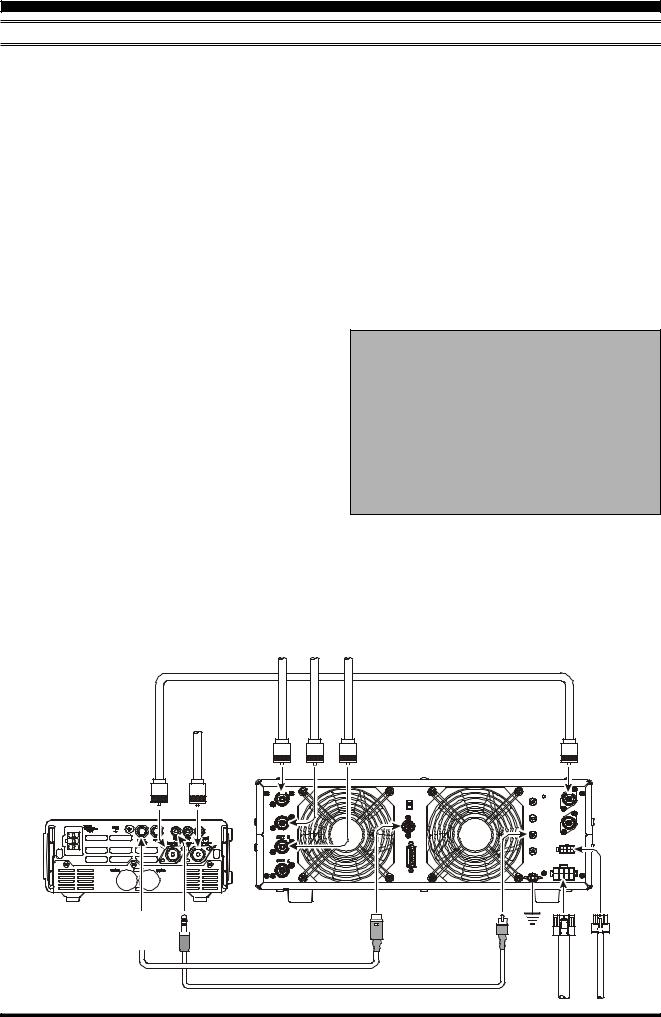
INSTALLATION
LINEAR AMPLIFIER INTERFACING
The FT-897 provides the switching and drive-control lines required for easy interfacing to most all commonly-avail- able amplifiers sold today.
These include:
The Antenna Jacks (“HF/50MHz” and “144/430MHz”);
AT/R control line (open circuit on RX, closure to ground on TX); and
A negative-going ALC jack (control voltage range: 0V to –4V DC).
When interfacing to the VL-1000 Solid State 1 KW Linear Amplifier, the optional CT-58 Interface Cable provides for easy interconnection (requires that the Menu Mode No-020 [CAT/LIN/TUN] setting changes to “LINEAR”).
The rear-panel CAT/LINEAR jack is an 8-pin, miniature DIN type, with the “TX GND” pin providing a closure to ground on transmit, for T/R control of your linear amplifier. The ACC jack is a miniature stereo type, with external ALC input capability on the tip connection. The main shaft is the ground return. The ring connection of the ACC jack, when closed to ground, places the FT-897 into the transmit mode, and sends a steady CW carrier, for amplifier (or antenna tuner) adjustment purposes.
Typical amplifier interface circuits are shown below.
Note that some amplifiers, particularly VHF or UHF “brick” amplifiers, offer two methods of T/R switching: application of +13V or a closure to ground.
To HF Antenna |
To HF Antenna |
Be sure to configure your amplifier so that it switches via a closure to ground, as provided by your FT-897's CAT/LINEAR jack (“TX GND” pin). Alternatively, many of these amplifiers use “RF Sensing” to control their relays; if yours is in this category, you may then use the T/R control line from the “TX GND” pin of the CAT/LINEAR jack for control of your HF linear amplifier, and RF sensing for your VHF or UHF amplifier.
The “TX GND” T/R control line is a transistor “open collector” circuit, capable of handling positive amplifier relay coil voltages of up to +50V DC and current of up to 400 mA. If you plan on using multiple linear amplifiers for different bands, you must provide external band-switching of the “TX GND” relay control line from the CAT/LINEAR jack.
Important Note!
Do not exceed the maximum voltage or current ratings for the “TX GND” line at the CAT/LINEAR jack. This line is not compatible with negative DC voltages, nor AC voltages of any magnitude.
Most amplifier control relay systems require only low DC voltage/current switching capability (typically, +12V DC at 25 ~ 75 mA), and the switching transistor in the FT-897 will easily accommodate such amplifiers.
To 50 MHz Antenna
CAT/LINEAR
430MHz Antenna |
|
ANT 1 |
ANT 2 |
ANT 3 |
|
|
INPUT 1 |
|
/ |
|
|
|
VL-1000 |
|
|
|
|
144 |
ANT 1 |
|
|
|
|
INPUT 1 |
|
|
To |
|
|
|
REMOTE |
|
PTT 1 |
|
|
|
|
|
ON |
|
|
|
|
|
|
|
|
|
OFF |
|
|
|
|
|
ANT 2 |
|
|
BAND DATA 1 |
|
PTT 2 |
|
|
|
|
|
|
|
|
INPUT 2 |
|
|
|
|
|
|
|
|
ALC 1 |
|
|
|
|
|
|
|
|
CONTROL |
|
|
|
|
|
|
|
|
ALC 2 |
|
|
|
|
|
|
|
|
DC48V IN |
|
|
|
|
|
|
|
|
GND |
|
|
|
|
|
|
BAND DATA 2 |
|
|
|
|
|
CT-58 BAND DATA Cable |
BAND-DATA 1 |
ALC 1 |
GND |
DC48V IN |
CONTROL |
||
|
|
CT-58 ALC Cable |
|
|
|
|
||
Page 10 |
FT-897 OPERATING MANUAL |
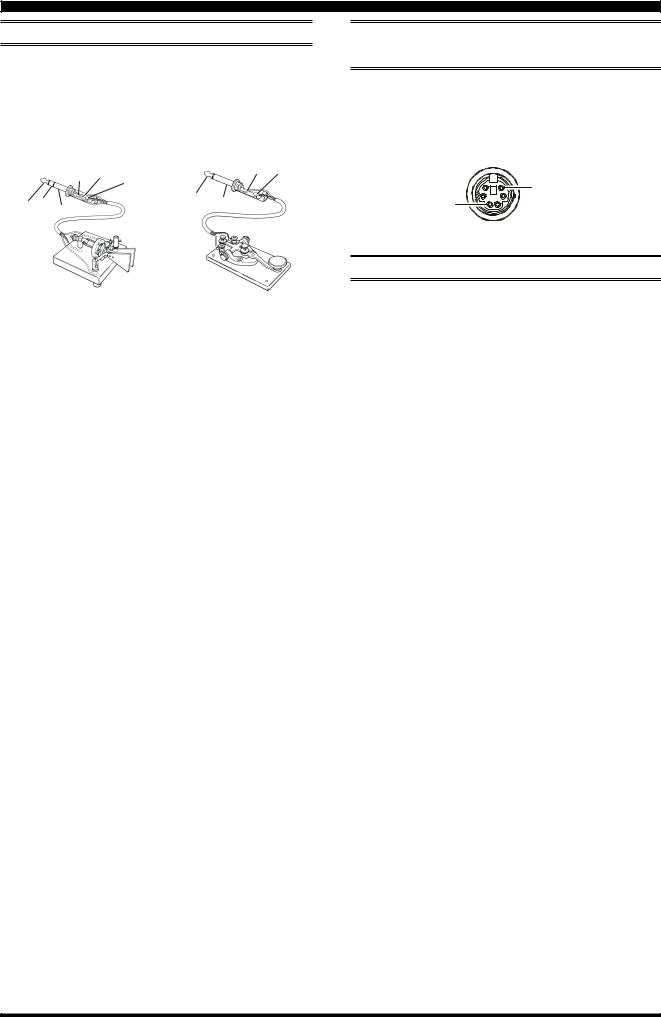
INSTALLATION
CW KEY/KEYER CONNECTIONS
All commonly-available keyer paddles should work perfectly with the built-in Electronic Keyer. The wiring configuration for the paddle is shown below.
For straight-key operation, only the tip and shaft connections are used.
|
DASH |
KEY GND |
DOT |
|
|
|
COMMON |
|
DOT DASH |
KEY |
GND |
|
|
|
COMMON |
|
|
Note: Even when using a straight key, you must use a threeconductor (“stereo”) plug. If a two-conductor plug is used, the key line will be constantly shorted to ground.
When using an external electronic keyer, be absolutely certain that it is configured for “positive” keying, not “negative” or “grid block” keying. The “key-up” voltage of the FT-897 is +5V, and the “key-down” current is only about 1 mA.
For CW automated keying using a personal computer, with an external memory keyer providing for manual sending, it usually is possible to connect the keyed lines together via a “Y” connector. Check with the documentation accompanying your keyer and your contest/DX software for any cautions which need to be observed.
RECEIVER ACCESSORIES
(TAPE RECORDER ETC.)
Connection of a tape recorder or other such receiver accessory is easily accomplished by using the DATA jack’s Data Out (1200 bps) terminal (Pin 5) and Ground (Pin 2). The audio output is fixed at 100 mV, with an impedance of 600
Ω.
DATA OUT
1200bps
GND
DATA
ADJUSTING THE FRONT BAIL
The front bail of the transceiver allows the transceiver to be tilted upward for better viewing. Simply fold bail forward to raise the front of the transceiver, and fold bail back against the bottom case to lower the front of the FT-897.
FT-897 OPERATING MANUAL |
Page 11 |
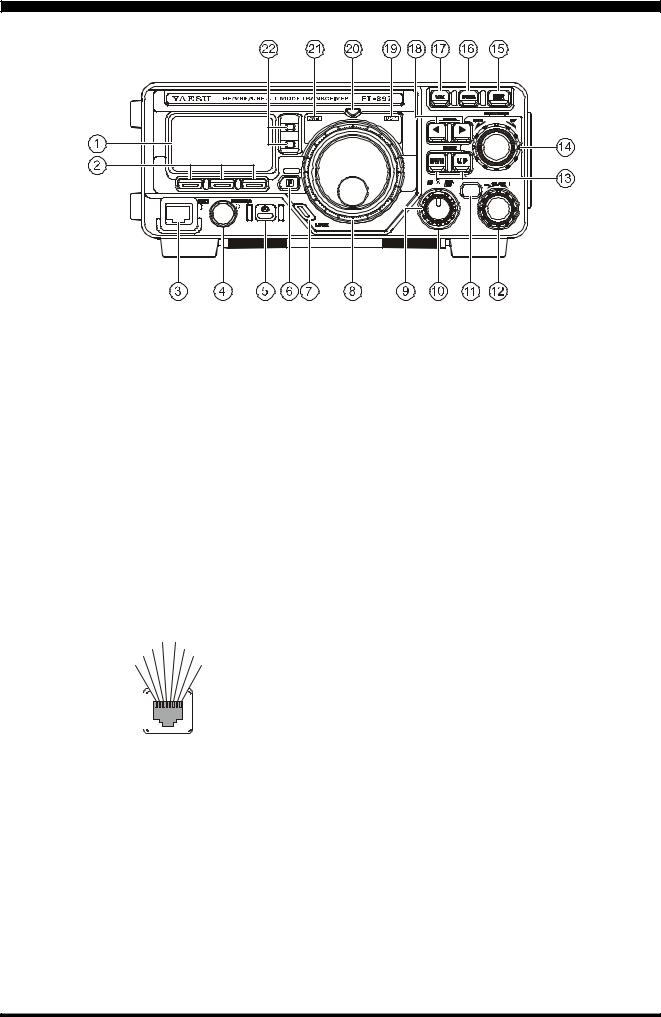
FRONT PANEL CONTROL & SWITCHES
BATT-A |
BATT-B |
 Liquid Crystal Display
Liquid Crystal Display
The Liquid Crystal Display (LCD) provides indication of the operating frequency and other aspects of transceiver status.
 FUNC Keys
FUNC Keys
These three keys select many of the most important operating features of the transceiver. When you press the [F] key, then rotate the MEM/VFO CH knob, the current function of that key will appear above each of the [A], [B], and [C] keys (along the bottom of the LCD). You may scroll the display through 17 rows of functions available for use via the [A], [B], and [C] keys.
The available features are shown in page 14.
 MIC Jack
MIC Jack
Connect the supplied MH-31A8J Hand Microphone to this jack.
MIC GND |
MIC |
|||||||||||||||||||
|
+5 V |
|
|
|
|
|
PTT |
|||||||||||||
UP |
|
|
|
|
|
|
|
GND |
||||||||||||
DOWN |
|
|
|
|
|
|
|
FAST |
||||||||||||
|
|
|
|
|
|
|
|
|
|
|
|
|
|
|
|
|
|
|
|
|
|
|
|
|
|
|
|
|
|
|
|
|
|
|
|
|
|
|
|
|
|
|
|
|
|
|
|
|
|
|
|
|
|
|
|
|
|
|
|
|
|
|
|
|
|
|
|
|
|
|
|
|
|
|
|
|
|
|
|
|
|
|
|
|
|
|
|
|
|
|
|
|
|
|
|
|
|
|
|
|
|
|
|
|
|
|
|
|
|
|
|
|
|
|
|
|
|
|
|
|
|
|
|
|
|
 PHONES Jack
PHONES Jack
This 1/4-inch, 3-contact jack accepts either monaural or stereo headphones with 2- or 3-contact plugs. When a plug is inserted, the loudspeaker is disabled. The audio level varies according to the setting of the front panel’s AF knob.
 POWER Switch
POWER Switch
Press and hold in the POWER switch for one second to turn to the transceiver on or off.
While the transceiver is turned on, pressing this switch momentarily will engage the “Fast Tuning” mode, to allow more rapid frequency navigation (a small “running man” icon will be observed in the bottom right-hand corner of the LCD).
 [F] Key
[F] Key
Press this key momentarily to enable the changing of the function of the Multi Function keys ([A], [B], and [C]) by the MEM/VFO CH knob.
Press and hold this key for one second to activate the “Menu” mode.
 LOCK Key
LOCK Key
Pressing this key locks the front panel keys so as to prevent accidental frequency change. The LOCK key itself, though, will never be disabled.
 MAIN DIAL
MAIN DIAL
This is the main tuning dial for the transceiver. It is used both for frequency tuning as well as “Menu” setting in the transceiver.
 AF Knob
AF Knob
The (inner) VOL knob adjusts the receiver audio volume level presented to the internal or external speaker. Clockwise rotation increases the volume level.
 SQL/RF Knob
SQL/RF Knob
In the USA version, this (outer) SQL/RF knob adjusts the gain of the receiver’s RF and IF stages. Using Menu Mode No-080 [SQL/RF GAIN], this control may be changed to function as a Squelch control, which may be used to silence background noise when no signal is present. In the other versions, its default setting is set to “Squelch.”
 CLAR/IF SHIFT Key
CLAR/IF SHIFT Key
Pressing this key activates the Receiver Clarifier feature. When this feature is activated, the CLAR knob is used to set a tuning offset of up to ±9.99 kHz. The transmitter’s frequency is not affected by the setting of the Clarifier.
Press and hold this key for one second to activate the IF Shift feature, which allows you to use the MEM/VFO CH knob to adjust the center frequency of the IF filter’s passband response.
Page 12 |
FT-897 OPERATING MANUAL |
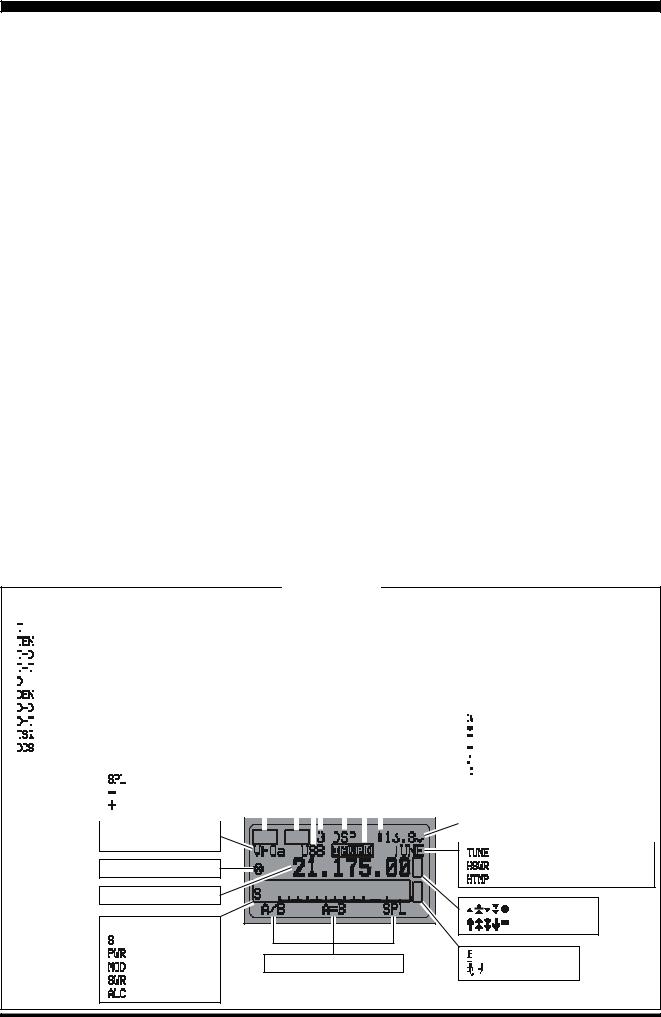
FRONT PANEL CONTROL & SWITCHES
 CLAR Knob
CLAR Knob
This knob tunes the clarifier offset frequency up to ±9.99 kHz, when the Receiver Clarifier feature is activated by pressing the CLAR/IF SHIFT key.
 BAND(DWN)/BAND(UP) Key
BAND(DWN)/BAND(UP) Key
Pressing either of these keys momentarily will cause the frequency to be moved up or down by one frequency band. The selections available are:
…1.8 MHz  3.5 MHz
3.5 MHz  7.0 MHz
7.0 MHz  10 MHz
10 MHz  14 MHz
14 MHz 15 MHz
15 MHz 18 MHz
18 MHz 24 MHz
24 MHz  28 MHz
28 MHz  50 MHz
50 MHz  88 MHz
88 MHz  108 MHz
108 MHz  144 MHz
144 MHz  430 MHz
430 MHz  1.8 MHz …
1.8 MHz …
 MEM/VFO CH Knob
MEM/VFO CH Knob
This detented rotary switch is used for VFO frequency tuning, memory selection, and function selection for the [A], [B], [C] keys of the transceiver.
 DSP Button
DSP Button
Pressing this button momentarily provides instant access to Multi Function Row “p” (MFp), which contains the command key for the receiver’s Digital Signal Processing system. The available functions will appear as the functions displayed above the [A], [B], and [C] keys, as described previously.
 HOME Key
HOME Key
Pressing this key momentarily recalls a favorite “Home” frequency memory.
 V/M Key
V/M Key
Pressing this key switches frequency control between the
VFO and Memory Systems.
 MODE( )/MODE( ) Key
MODE( )/MODE( ) Key
Pressing either of these keys momentarily will change the operating mode. The selections available are:
… USB  LSB
LSB  CW
CW  CWR
CWR 
 AM
AM  DIG
DIG  PKT
PKT  USB …
USB …
 DSP Indicator
DSP Indicator
This indicator glows green when the DSP feature is activated.
 TRANSMIT/BUSY Indicator
TRANSMIT/BUSY Indicator
This indicator glows green when the squelch opens, and turns red during transmit.
 CW-T Indicator
CW-T Indicator
This indicator is a visual tinning indicator for CW reception, which glows green in synchronization with a signal tuned to the center of the IF passband during CW reception.
 BATT-A, BATT-B Indicator
BATT-A, BATT-B Indicator
These LEDs indicate the battery status for the optional FNB-78 Ni-MH battery pack while internal battery operation.
The LED glows green when the battery pack is waiting (switch to off by the A-B switch on the top panel), and turns orange when the is the battery pack en the radio operate the corresponded battery pack by the A-B switch on the top panel.
When the battery voltage is approaching the value which indicates depletion is near, the LED blinks orange, indicating it is time to replace the batteries.
LCD Details
CTCSS/DCS Status |
|
|
|
|
|
|
|
|
|
|
|
|
|
|
|
|
|
|
|
|
|
|
|
|
|
|
|
|
|
|
|
|
|
|||||
|
|
|
: CTCSS ENC Active (Split Tone “ON”) |
|
|
|
|
|
|
|
|
|
|
|||||||||||||||||||||||||
|
|
|
|
|
|
|
|
|
|
|
|
|
|
|
|
|
|
|
|
|
|
|
|
|
|
|||||||||||||
|
|
|
: CTCSS ENC Active (Split Tone “OFF”) |
|
|
|
|
|
|
|
|
|
|
|
|
|
|
|
|
|
|
|
|
|
|
Operating Mode |
|
|||||||||||
|
|
|
|
|
|
|
|
|
|
|
|
|
|
|
|
|
|
|
|
|
|
|
|
|
|
|||||||||||||
|
|
|
: CTCSS ENC/DCS DEC Active (Split Tone “ON”) |
|
|
|
|
|
|
|
|
|
|
|
|
|
|
|
|
|
|
|
|
|
|
|
|
|
||||||||||
|
|
|
|
|
|
|
|
|
|
|
|
|
|
|
|
|
|
|
|
|
|
|
|
|
|
|
|
|||||||||||
|
|
|
: CTCSS ENC/DEC (Tone Squelch) Active (Split Tone “ON”) |
|
|
|
|
|
|
|
|
|
|
|
|
|
|
|
|
|
|
|
|
|
|
APO Active |
|
|||||||||||
|
|
|
|
|
|
|
|
|
|
|
|
|
|
|
|
|
|
|
|
|
|
|
|
|
|
|||||||||||||
|
|
|
: DCS ENC Active (Split Tone “ON”) |
|
|
|
|
|
|
|
|
|
|
|
|
|
|
|
|
|
|
|
|
|
|
|
|
|
||||||||||
|
|
|
|
|
|
|
|
|
|
|
|
|
|
|
|
|
|
|
|
|
|
|
|
|
|
|
|
|||||||||||
|
|
|
: DCS ENC Active (Split Tone “OFF”) |
|
|
|
|
|
|
|
|
|
|
|
|
|
|
|
|
|
|
|
|
|
|
DCS Active |
|
|||||||||||
|
|
|
|
|
|
|
|
|
|
|
|
|
|
|
|
|
|
|
|
|
|
|
|
|
|
|||||||||||||
|
|
|
: DCS ENC/DEC Active (Split Tone “ON”) |
|
|
|
|
|
|
|
|
|
|
|||||||||||||||||||||||||
|
|
|
|
|
|
|
|
|
|
|
|
|
|
|
|
|
|
|
|
|
|
|
|
|
|
|
|
|||||||||||
|
|
|
|
|
|
|
|
|
|
|
|
|
||||||||||||||||||||||||||
|
|
|
: DCS ENC/CTCSS DEC Active (Split Tone “ON”) |
|
|
|
|
|
|
|
|
|
|
|
|
|
|
|
|
|
|
|
|
|
|
|
: IPO Active |
|
||||||||||
|
|
|
: CTCSS ENC/DEC (Tone Squelch) Active (Split Tone “OFF”) |
|
|
|
|
|
|
|
|
|
|
|
|
|
|
|
|
|
|
|
|
|
|
|
: ATT Active |
|
||||||||||
|
|
|
: DCS ENC/DEC Active (Split Tone “OFF”) |
|
|
|
|
|
|
|
|
|
|
|
|
|
|
|
|
|
|
|
|
|
|
|
: VOX Active |
|
||||||||||
|
|
|
|
|
|
|
|
|
|
|
|
|
|
|
|
|
|
|
|
|
|
|
|
|
|
|
|
|
|
|
|
|
|
|
|
|
: Priority Active |
|
|
|
|
|
|
|
|
|
|
|
|
|
|
|
|
|
|
|
|
|
|
|
|
|
|
|
|
|
|
|
|
|
|
|
|
|
|
: Dual Receive Active |
|
|
|
|
|
|
|
: Odd Split |
|
|
|
|
|
|
|
|
|
|
|
|
|
|
|
|
|
|
|
|
|
|
|
|
|
|
|
|
|
|
|
|
|
|
|
|
|
|
|
|
|
|
|
|
|
|
|
|
|||||||||||||||||||||||
|
|
: |
Minus Shift |
|
|
|
|
|
|
|
|
|
|
|
|
|
|
|
|
|
|
|
|
|
|
|
|
|
|
|
|
|||||||
|
|
|
|
|
|
|
|
|
|
|
|
|
|
|
|
|
|
|
|
|
|
|
|
|
|
|
|
|
|
|
|
|
Battery Operation |
|
||||
|
|
|
|
: |
Plus Shift |
|
|
|
|
|
|
|
|
|
|
|
|
|
|
|
|
|
|
|
|
|
|
|
|
|
|
|
|
|
|
|||
|
|
|
|
|
|
|
|
|
|
|
|
|
|
|||||||||||||||||||||||||
|
|
|
|
|
|
|
|
|
|
|
|
|
|
|
|
|
|
|
|
|
|
|
|
|
|
|
|
|
|
|
|
|
|
|
|
|||
|
|
|
|
|
|
|
|
|
|
|
|
|
|
|
|
|
|
|
|
|
|
|
|
|
|
|
|
|
|
|
|
|
|
|
|
|
|
|
|
|
|
|
VFO A/B or |
|
|
|
|
|
|
|
|
|
|
|
|
|
|
|
|
|
|
|
|
|
|
|
|
|
Supply Voltage |
|
|||||||
|
|
|
|
Memory CH Number |
|
|
|
|
|
|
|
|
|
|
|
|
|
|
|
|
|
|
|
|
|
|
|
|
|
|
|
|
|
|||||
|
|
|
|
|
|
|
|
|
|
|
|
|
|
|
|
|
|
|
|
|
|
|
|
|
|
|
|
|
|
|
|
|||||||
|
|
|
: ATAS-100/-120 or FC-30 Active |
|
Transverter Mode |
|
: HI SWR (more the “3.0”) |
|
|
: HI Temperature |
|
|
|
|
|
Operating Frequency |
|
|
|
|
|
|
: IF SHIFT Active |
Meter Status |
|
: Clarifier Active |
|
|
|
||
: |
S meter |
|
|
|
: PO meter |
|
: Key Lock “ON” |
|
|
Multi Function Key Status |
|
|
: Modulation Meter |
/ : Fast Tuning Step |
|
|
|
|
|
|
: SWR Meter |
|
|
|
: ALC Meter |
|
|
FT-897 OPERATING MANUAL |
Page 13 |
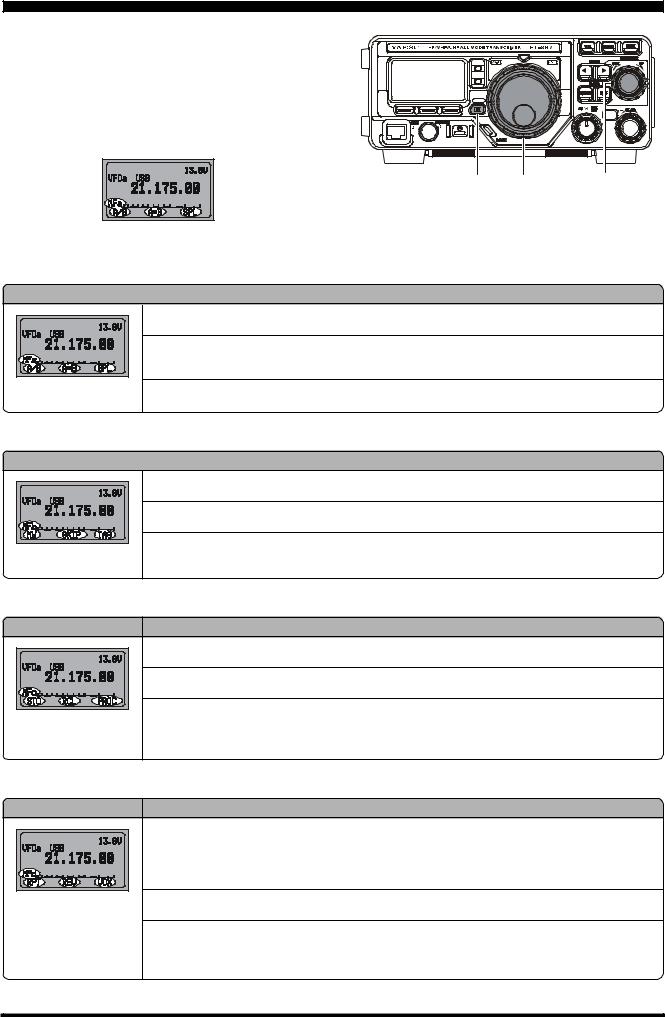
FRONT PANEL CONTROL & SWITCHES
The [A], [B], and [C] keys select many of the most important operating features of the transceiver. When you press the [F] key, then rotate the MEM/VFO CH knob, the current function of that key will appear above each of the [A], [B], and [C] keys (along the bottom of the LCD). You may scroll the display through 17 rows of functions available for use via the [A], [B], and [C] keys.
|
|
|
[A] |
[B] |
[C] |
BATT-A
BATT-B
F DIAL MEM/VFO CH
Multi Function Row “a” (MFa) [A/B, A=B, SPL]
|
|
|
[A] |
[B] |
[C] |
[A] Key: A/B
Press the [A](A/B) key to switch between VFO-A and VFO-B on the display.
[B] Key: A=B
Press the [B](A=B) key to copy the contents of Main VFO to be copied into the Sub VFO, so that the two VFO’s contents will be identical.
[C] Key: SPL
Press the [C](SPL) key to activate Split frequency operation between VFO-A and VFO-B.
Multi Function Row “b” (MFb) [MW, SKIP, TAG]
|
|
|
[A] |
[B] |
[C] |
[A] Key: MW
Press and hold in the [A](MW) key for one second to transfer the contents of the VFO into a Memory register.
[B] Key: SKIP
Press the [B](SKIP) key to designate the current Memory channel to be “skipped” during scanning.
[C] Key: TAG
Press the [C](TAG) key to select the display type (Frequency or Alpha-numeric Tag) during Memory operation.
|
|
|
|
|
|
|
|
Multi Function Row “c” (MFc) [STO, RCL, PROC] |
|
|
|
|
[A] Key: STO |
|
|
|
|
Press the [A](STO) key to store the contents of the VFO into the QMB (Quick Memory Bank) register. |
|
|
|
|
[B] Key: RCL |
|
|
|
|
Press the [B](RCL) key to recall the QMB Memory. |
|
|
|
|
[C] Key: PROC |
|
Press the [C](PROC) key to activate the speech processor for SSB and AM transmission. |
||||
[A] |
[B] |
[C] |
||
Press and hold in the [C](PROC) key for one second to recall Menu Mode No-074 [PROC LEVEL] (for setting the |
||||
|
|
|
||
|
|
|
compression level of the AF Speech Processor). |
|
|
|
|
|
|
|
|
|
Multi Function Row “d” (MFd) [RPT, REV, VOX] |
|
|
|
|
[A] Key: RPT |
|
|
|
|
Press the [A](RPT) key to select the direction of the uplink frequency shift (+, –, or simplex) during FM repeater |
|
|
|
|
operation. |
|
|
|
|
Press and hold in the [A](RPT) key for one second to recall Menu Mode No-076 [RPT SHIFT] (for setting the shift |
|
|
|
|
frequency offset). |
|
|
|
|
[B] Key: REV |
|
[A] |
[B] |
[C] |
Press the [B](REV) key to reverse the transmit and receive frequencies while working through a repeater. |
|
|
|
|
[C] Key: VOX
Press the [C](VOX) key enable the VOX (voice-operated transmitter switching system) in the SSB, AM, and FM modes. Press and hold in the [C](VOX) key for one second to recall Menu Mode No-088 [VOX GAIN] (for setting the VOX gain level).
Page 14 |
FT-897 OPERATING MANUAL |
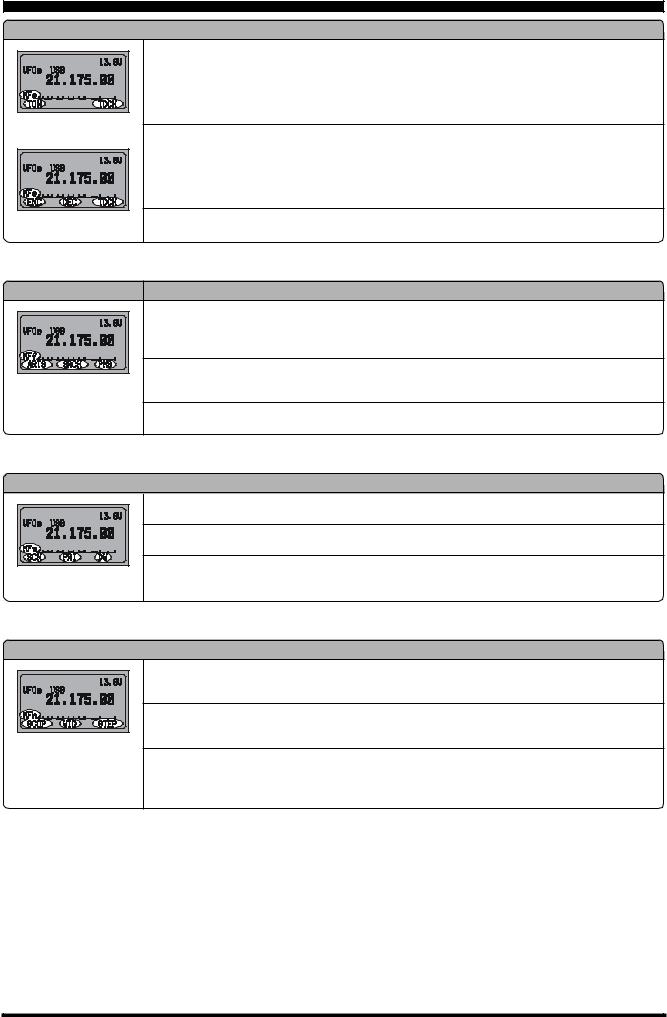
FRONT PANEL CONTROL & SWITCHES
Multi Function Row “e” (MFe) [TON, -------, TDCH] ([ENC, DEC, TDCH])
|
|
|
[A] |
[B] |
[C] |
|
|
|
[A] |
[B] |
[C] |
[A] Key: TON/ENC
Press the [A](TON) key to activate CTCSS or DCS operation on FM.
When the Split Tone feature is activated via Menu Mode No-079 [SPLIT TONE], this key function changes to “ENC” for activation of the CTCSS Encoder or DCS Encoder. Press the [A](ENC) key to activate the encoder.
Press and hold in the [A](TON/ENC) key for one second to recall Menu Mode No-083 [TONE FREQ] (for selecting the CTCSS tone frequency).
[B] Key: ------/DEC
Normally, this key does nothing.
When the Split Tone feature is activated via Menu Mode No-079 [SPLIT TONE], this key function changes to “DEC” to engage the DCS or CTCSS Decoder. Press the [B](DEC) key to activate the decoder.
Press and hold in the [B](DEC) key for one second to recall Menu Mode No-033 [DCS CODE] (for selecting the DCS code).
[C] Key: TDCH
Press the [C](TDCH) key to initiate CTCSS Tone or DCS Search.
|
|
|
|
|
|
|
Multi Function Row “f” (MFf) [ARTS, SRCH, PMS] |
|
|
|
[A] Key: ARTS |
|
|
|
Press the [A](ARTS) key to initiate the Auto-Range Transponder mode. |
|
|
|
Press and hold in the [A](ARTS) key for one second to recall Menu Mode No-008 [ARTS BEEP] (for selecting the ARTS |
|
|
|
“Beep” option). |
|
|
|
[B] Key: SRCH |
|
|
|
Press the [B](SRCH) key to activate the Smart Search feature. |
[A] |
[B] |
[C] |
Press the [B](SRCH) key to initiate Smart Search scanning. |
|
|
|
|
|
|
|
[C] Key: PMS |
|
|
|
Press the [C](PMS) key to activate the Programmable Memory Scan feature. |
Multi Function Row “g” (MFg) [SCN, PRI, DW]
|
|
|
[A] |
[B] |
[C] |
[A] Key: SCN
Press the [A](SCN) key to initiate the Scanning (in the direction of higher frequencies).
[B] Key: PRI
Press the [B](PRI) key to activate the Priority Scan feature.
[C] Key: DW
Press the [C](DW) key to activate the Dual Watch feature.
Multi Function Row “h” (MFh) [SCOP, WID, STEP]
|
|
|
[A] |
[B] |
[C] |
[A] Key: SCOP
Press the [A](SCOP) key to activate the Spectrum Scope Monitor feature.
Press and hold in the [A](SCOP) key for one second to initiate the Spectrum Scope.
[B] Key: WID
Press the [B](WID) key to select the visible bandwidth for the Spectrum Scope Monitor.
Press and hold in the [B](WID) key for one second to select the operating mode for the Spectrum Scope Monitor.
[C] Key: STEP
Press the [C](STEP) key to select the channel steps for Spectrum Scope Monitor.
Press and hold in the [C](STEP) key for one second to activate the MAX HOLD feature, which will display and hold the peak signal strength level for each channel.
FT-897 OPERATING MANUAL |
Page 15 |
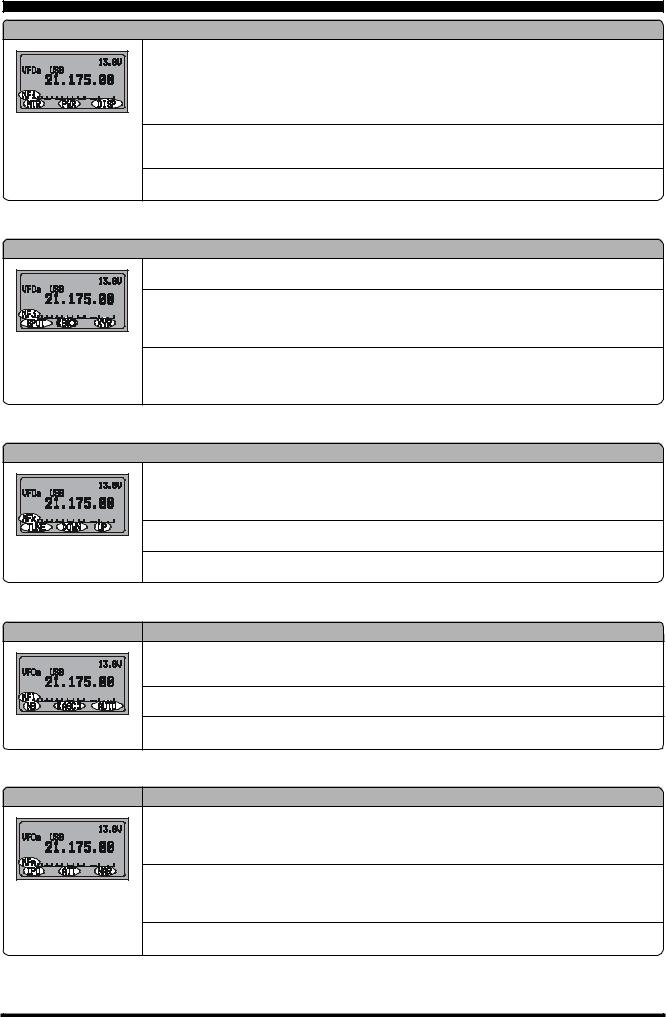
FRONT PANEL CONTROL & SWITCHES
Multi Function Row “i” (MFi) [MTR, --------, DISP]
|
|
|
[A] |
[B] |
[C] |
[A] Key: MTR
Pressing the [A](MTR) key repeatedly allows selection of the display function of the meter in the transmit mode.
PWR ALC SWR MOD PWR …… The selected function will appear above the [B] key.
Press and hold in the [A](MTR) key for one second to recall Menu Mode No-062 [MTR PEAK HOLD] (for setting the “Peak-Hold” function of the meter).
[B] Key
Pressing the [B] key repeatedly allows selection of the display function of the meter in the transmit mode.
PWR MOD SWR ALC PWR ……
[C] Key: DISP
Press the [C](DISP) key to switch the display between the Large Character and Small Character modes.
Multi Function Row “j” (MFj) [SPOT, BK, KYR]
|
|
|
[A] |
[B] |
[C] |
[A] Key: SPOT
Press the [A](SPOT) key to activate the CW spotting heterodyne oscillator.
[B] Key: BK
Press the [B](BK) key to disable the CW “Semi” break-in operation.
Press and hold in the [B](BK) key for one second to recall Menu Mode No-029 [CW SIDE TONE] (for setting the CW side tone volume level).
[C] Key: KYR
Press the [C](KYR) key to activate the built-in Electronic Keyer.
Press and hold in the [C](KYR) key for one second to recall Menu Mode No-030 [CW SPEED] (for setting the Keyer speed).
Multi Function Row “k” (MFk) [TUNE, DOWN, UP]
|
|
|
[A] |
[B] |
[C] |
[A] Key: TUNE
Press the [A](TUNE) key to activate the optional FC-30 Automatic Antenna Tuner or ATAS-100/-120 Active-Tuning Antenna System.
Press and hold in the [A](TUNE) key for one second to initiate tuner or antenna retuning.
[B] Key: DOWN
Press and hold in the [B](DOWN) key to lower the ATAS-100/-120 antenna manually.
[C] Key: UP
Press and hold in the [C](UP) key to raise the ATAS-100/-120 antenna manually.
Multi Function Row “l” (MFl) [NB, AGC, --------]
|
|
|
[A] Key: NB |
|
|
|
|
Press the [A](NB) key to activate the receiver’s IF Noise Blanker. |
|
|
|
|
Press and hold in the [A](NB) key for one second to recall Menu Mode No-63 [NB LEVEL] (for setting of the NB level). |
|
|
|
|
[B] Key: AGC |
|
|
|
|
Press the [B](AGC) key to disable the receiver’s AGC system. Normally, the AGC should be left On. |
|
|
|
|
[C] Key |
|
[A] |
[B] |
[C] |
||
Press the [C] key to select the recovery time (Slow, Fast, or Auto) for the receiver’s AGC system. |
||||
|
|
|
||
|
|
|
Multi Function Row “m” (MFm) [IPO, ATT, NAR] |
|
|
|
|
[A] Key: IPO |
|
|
|
|
Press the [A](IPO) key to bypass the receiver preamplifier, thereby activating Intercept Point Optimization for improved |
|
|
|
|
overload characteristics while operating on the HF and 50 MHz bands. |
|
|
|
|
The IPO feature does not function on 144/430 MHz. |
|
|
|
|
[B] Key: ATT |
|
|
|
|
Press the [B](ATT) key to engage the receiver front-end attenuator, which will reduce all signals and noise by approxi- |
|
[A] |
[B] |
[C] |
mately 10 dB. |
|
|
|
|
||
|
|
|
The ATT feature does not function on 144/430 MHz. |
|
|
|
|
[C] Key: NAR |
|
|
|
|
Press the [C](NAR) key to select the low-deviation mode required for HF FM operation on 29 MHz. |
Page 16 |
FT-897 OPERATING MANUAL |
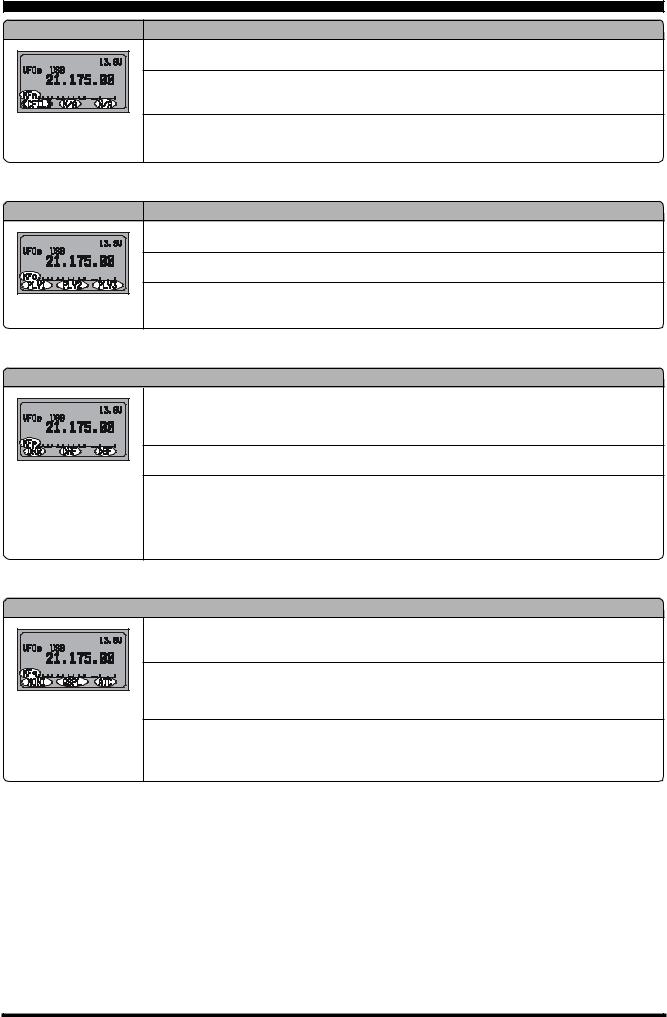
FRONT PANEL CONTROL & SWITCHES
Multi Function Row “n” (MFn) [CFIL,--------,--------]
|
|
|
[A] Key: CFIL |
|
|
|
|
Press the [A](CFIL) key to select the 2.4 kHz ceramic IF filter. |
|
|
|
|
[B] Key |
|
|
|
|
Press the [B] key to select the optional IF filter which is located on the “FIL-1” (Optional Filter 1) slot on the Main Unit. |
|
|
|
|
When an optional filter is not installed on the“FIL-1” slot, this key function is disabled, and its label is “N/A.” |
|
|
|
|
[C] Key |
|
[A] |
[B] |
[C] |
||
Press the [C] key to select the optional IF filter which is located on the “FIL-2” (Optional Filter 2) slot on the Main Unit. |
||||
|
|
|
||
|
|
|
When an optional filter is not installed on the“FIL-2” slot, this key function is disabled, and its label is “N/A.” |
Multi Function Row “o” (MFo) [PLY1, PLY2, PLY3]
[A] Key: PLY1
Press the [A](PLY1) key to send the CW message which is memorized in BEACON TEXT 1.
[B] Key: PLY2
Press the [B](PLY2) key to send the CW message which is memorized in Keyer BEACON TEXT 2.
[C] Key: PLY3
Press the [C](PLY3) key to send the CW message which is memorized in Keyer BEACON TEXT 3.
Multi Function Row “p” (MFp) [DNR, DNF, DBF]
|
|
|
[A] |
[B] |
[C] |
[A] Key: DNR
Press the [A](DNR) key to activate the DSP Noise Reduction system.
Press and hold in the [A](DNR) key for one second recall Menu Mode No-049 [DSP NR LEVEL] (for setting the degree of DSP Noise Reduction).
[B] Key: DNF
Press the [B](DNF) key to activate the DSP’s Auto Notch Filter.
[C] Key: DBF
Press the [C](DBF) key to activate the DSP’s receiver Bandpass Filter.
In the SSB, AM, FM, and AFSK modes, press and hold in the [C](DBF) key for one second to recall Menu Mode No047 [DSP LPF CUTOFF] (for adjusting the high-frequency cutoff of the DSP Bandpass Filter).
In the CW mode, press and hold in the [C](DBF) key for one second to recall Menu Item No-045 [DSP BPF WIDTH] (for setting the CW bandwidth).
Multi Function Row “q” (MFq) [MONI, QSPL, ATC]
|
|
|
[A] |
[B] |
[C] |
[A] Key: MONI
Press the [A](MONI) key to disable the Noise Squelch.
You may program the configuration of this key by the Menu Mode No-065 [PG A].
[B] Key: QSPL
Press the [B](QSPL) key to change the Sub VFO frequency (Main VFO frequency + 5 kHz) and automatically engage the “Split” feature.
You may program the configuration of this key by the Menu Mode No-066 [PG B].
[C] Key: ATC
Press the [C](ATC) key to activate a 1750-Hz burst tone for 2 seconds when pressing the PTT switch while the channel is clear.
You may program the configuration of this key by the Menu Mode No-067 [PG C].
FT-897 OPERATING MANUAL |
Page 17 |
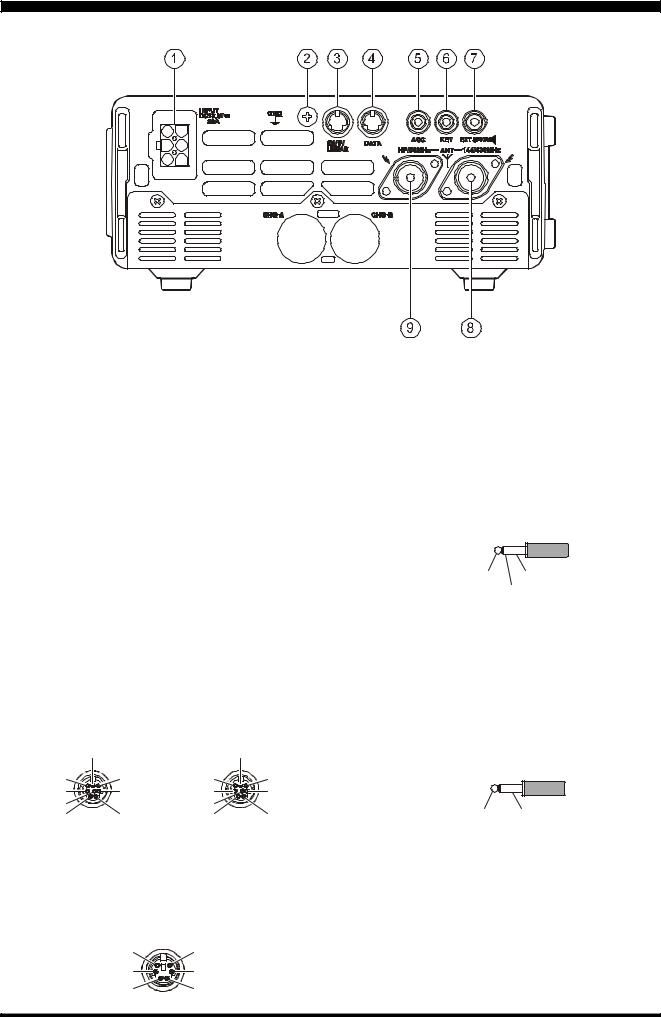
REAR PANEL CONNECTORS
 INPUT Jack
INPUT Jack
This is the DC power supply connection for the transceiver, used when operating the transceiver with an external power supply. Use the supplied DC cable to connect this jack to the car battery or DC power supply, which must be capable of supplying at least 22A @ 13.8 VDC. For base station operation, the optional FP-30 External AC power supply may be attached to the bottom of the transceiver and connect the output pigtail of the FP-30 to this jack.
 ACC Jack
ACC Jack
This 3.5-mm 3-pin jack accepts externalALC (Automatic Level Control) voltage from a linear amplifier on the tip connection, and accepts a “Transmit Request” command on the ring connection. The main shaft is the ground return.
The “TX Request” connection, when shorted to ground, puts the FT-897 into the transmit mode, and sends out a steady CW carrier, for linear amplifier or manual antenna tuner adjustment.
 GND Terminal
GND Terminal
For best performance and safety, this Ground lug may be connected to a good earth ground using a short, heavy, braided cable.
 CAT/LINEAR Jack
CAT/LINEAR Jack
This 8-pin mini-DIN jack is used for connection to the FC-30 ExternalAutomaticAntenna Tuner or ATAS-100/ -120 Active-Tuning Antenna System. It is also used for interfacing to a personal computer for control of the transceiver using the CAT system, and for interconnection to the VL-1000 Linear Amplifier.
|
RESET |
|
BAND D |
TX INH |
BAND C |
TX INH |
BAND C |
RX D |
GND |
BAND B |
GND |
TX D |
|
BAND A |
|
TX GND |
+13.8V |
TX GND |
+13.8V |
|
CAT/TUNER |
|
LINEAR |
 DATA Jack
DATA Jack
This 6-pin, mini-DIN jack accepts AFSK input from a Terminal Node Controller (TNC); it also provides fixedlevel Receiver Audio Output, Push-To-Talk (PTT), Squelch Status, and ground lines.
SQL |
DATA OUT |
|
1200bps |
||
|
||
DATA OUT |
PTT |
|
9600bps |
||
|
||
GND |
DATA IN |
DATA
EXT ALC |
|
GND |
|
TX REQ
 KEY Jack
KEY Jack
This 3.5-mm, 3-pin jack is used for connection to a CW keyer paddle or a straight key.
 EXT SPKR Jack
EXT SPKR Jack
This 3.5-mm, 2-pin jack provides variable audio output for an external speaker. The audio output impedance at this jack is 4 Ω ~ 16 Ω and the level varies according to the setting of the front panel’s AF control.
SIGNAL GND
 144/430 MHz Antenna Jack
144/430 MHz Antenna Jack
Connect your 144 and/or 430 MHz antenna’s 50 Ω coaxial cable to this M-type (“SO-239”) connector.
 HF/50 MHz Antenna Jack
HF/50 MHz Antenna Jack
Connect your HF and/or 50 MHz antenna’s 50 Ω coaxial cable to this M-type (“SO-239”) connector.
Page 18 |
FT-897 OPERATING MANUAL |

TOP & BOTTOM PANEL CONNECTORS
|
|
|
|
|
|
|
Top Panel Switch |
Bottom Panel Connector |
|||||
|
|
|
|
|
|
|
|
|
|
|
|
|
|
|
|
|
|
|
|
|
|
|
|
|
|
|
|
|
|
|
|
|
|
|
A-B Switch |
METER Jack |
Selects the battery pack to be used, when you have in- |
This 3.5-mm 2-pin jack is used for connection to an ana- |
stalled two optional FNB-78 Ni-MH battery packs into |
log meter (not produced by Vertex Standard). |
the FT-897. |
Please refer to the MENU No-060 and No-061. |
|
SIGNAL GND |
FT-897 OPERATING MANUAL |
Page 19 |
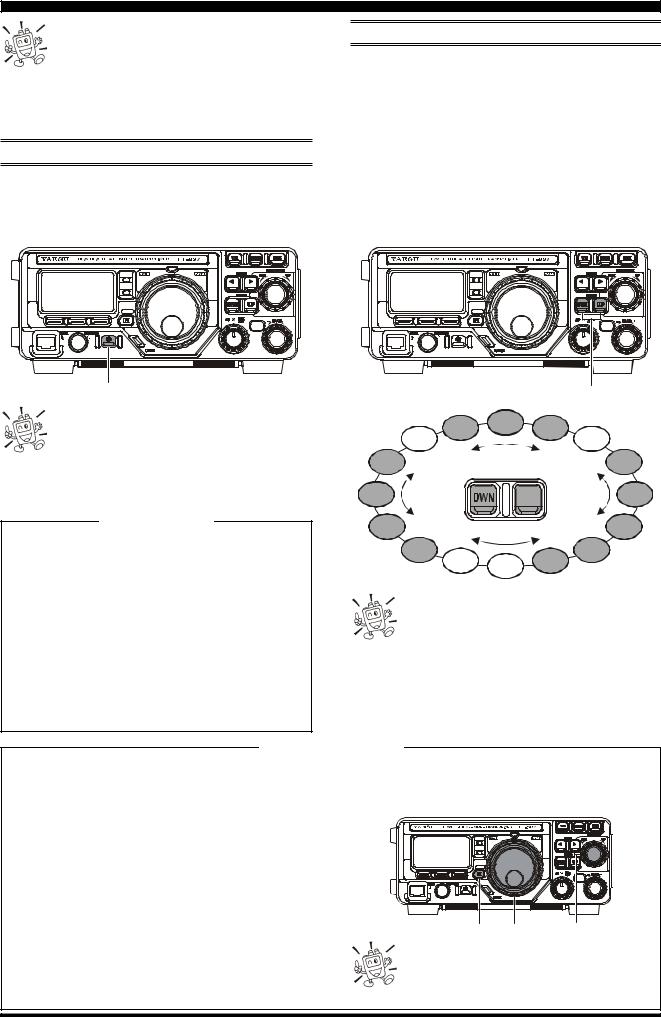
OPERATION
Hi! I’m R.F. Radio, and I’m here to guide you through the fine points of the setup and use of your new FT-897. I know you’re anxious to get
on the air, but I encourage you to read the “Operation” section of this manual as thoroughly as possible, so you’ll get the most out of this fantastic new rig. Now. . .let’s get operating!
TURNING THE TRANSCEIVER ON AND OFF
To turn the transceiver on, press and hold in the POWER switch for one second.
To turn the transceiver off, again press and hold in the POWER switch for one second.
OPERATING BAND SELECTION
This transceiver covers an incredibly wide frequency range, over which a number of different operating modes are used. Therefore, this transceiver’s frequency coverage has been divided into different operating bands, each of with has its own pre-set frequency steps and operating modes. You can change the channel steps and operating mode once you get started, of course, per the next section.
To change the frequency band, press either the BAND(DWN) or BAND(UP) key to move to the next lower or higher operating band, respectively.
BATT-A
BATT-B
BATT-A
BATT-B
POWER
When you are operating the FT-897 with the optional FP-30 External power supply, always turn on the MAIN switch on the FP-30 before
turning on the POWER switch on the FT-897. When shutting down, please turn off the POWER switch on the FT897 before turning off the MAIN switch on the FP-30.
LCD Contrast
If you experience difficulty in reading the main display, try adjusting the LCD’s contrast, using the Menu mode.
1.Press and hold in the [F] button for one second to activate the Menu mode.
2.Rotate the MEM/VFO CH knob to select Menu Mode No-042 [DISP CONTRAST].
3.Rotate the DIAL knob to adjust the contrast. As you make the adjustment, you will be able to see the effects of you changes.
4.When you have completed the adjustment, press and hold in the [F] button for one second to exit the Menu mode.
|
|
BAND |
7 MHz |
10 MHz |
14 MHz |
|
||
5 MHz |
|
15 MHz |
3.5 MHz |
|
18 MHz |
|
BAND |
|
1.8 MHz |
UP |
21 MHz |
|
|
|
430 MHz |
|
24.5 MHz |
144 MHz |
|
28 MHz |
108 MHz |
|
50 MHz |
|
88 MHz |
|
VFOa and VFOb are independent VFOs, so they may be set to different bands. See the “Stacked VFO System” discussion on page 22
for details.
Menu Quick Start
Many aspects of this transceiver’s configuration may be customized using the convenient “Menu” system, which allow you to configure many “set and forget” settings just the way you want to. A full discussion of the Menu system begins on page 52; for now, here is a brief discussion on how to change Menu settings:
1. Press and hold in the [F] key for one second to enter the Menu mode.
2. Rotate the MEM/VFO CH knob to recall the Menu Item to be changed (for example, Menu Mode No-001 [EXT MENU], which Enables or Disables the “Extended Menu” Mode).
3. Rotate the DIAL knob to set this feature (in this example, the default setting is “OFF (Disabled),” so rotate the DIAL knob to set this feature to “ON” (Enabled).
4. Press and hold in the [F] key for one second to save the new setting and exit to normal operation.
Page 20
